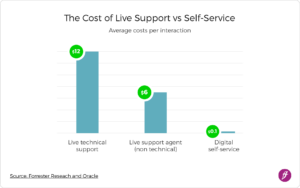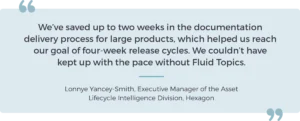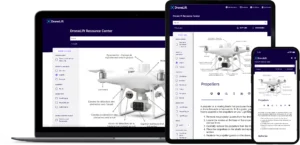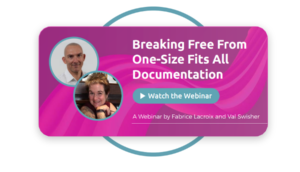The difference between providing poor and highly effective documentation determines whether or not your teams ensure a positive user experience, enhance employee productivity, and save the company operational costs. Documentation teams have the power to impact valuable outcomes and company ROI, yet managing and delivering content at scale is a complex, time-consuming process. With documentation challenges like outdated content, siloed information, and disconnected tools and systems, it’s no surprise that teams often struggle to overcome these hurdles.
That’s where an Enterprise Knowledge Platform (EKP) comes in. This solution is designed to tackle the biggest and most common issues plaguing documentation teams.
In this article, we’ll explore nine big challenges teams face with documentation and show how the right platform can solve them. Finally, uncover how solving these difficulties paves the way for the smooth integration of new innovative technologies like Generative AI (GenAI).
What is Documentation?
Documentation refers to all internal and external documents, images, and videos relevant to understanding a company’s business, procedures, products, and services. It includes content such as user guides, FAQs, troubleshooting tips, step-by-step instructions, and more. It can be either publicly accessible or restricted to specific users and serves various purposes, such as product support, maintenance, or sales enablement.
This broad definition also covers knowledge content produced by HR, Legal, Marketing and IT teams, along with technical documentation. Technical documentation refers to materials created to describe the use, functionality, or architecture of a product, system, or service.
What are the Benefits of Accessible Documentation?
Users expect to find exactly the information they need, when and where they need it. By meeting these expectations and mitigating documentation challenges, your company will reap the benefits of providing relevant documentation.
- Enhanced Customer Satisfaction: Customers want quick, precise answers. Research shows that 72% of users prioritize immediate assistance and 86% of B2B customers favor self-service digital options. By offering relevant, actionable documentation through self-service channels, you empower customers to resolve issues on their own. This accelerates resolution times and enhances their confidence and overall satisfaction with your product or service.
- Improved Employee Productivity: Knowledge workers spend about 30% of the workday looking for information. From new hires to veteran employees, your teams need accurate, relevant information to make quick, effective decisions. This is why 74% of organizations agree that effectively managing company knowledge content, including making it accessible to employees, increases company productivity by 10-40%.
- Reduced Costs: Accessible documentation reduces employee and customer costs. In 2023, companies across industries spent an average of $954 to train new hires. With easy access to detailed information, new employees can quickly become self-sufficient by leveraging the knowledge shared within the organization. On the customer side, users can resolve issues through self-service documentation instead of relying on support agents, which proves to be a more cost-effective approach to customer support.

What is an Enterprise Knowledge Platform?
An Enterprise Knowledge Platform (EKP) is a software solution that centralizes and unifies content from a wide variety of sources and formats. It connects users with the right product knowledge exactly when and where they need it—whether through a documentation portal, knowledge base, CRM, website, or AI-powered tools (i.e. chatbot). This enables companies to provide a seamless content experience to users on their preferred devices and across various touchpoints.
With a focus on content security, compliance, and accessibility, EKPs also ensure the protection of sensitive data. They offer full traceability and customizable entitlements, safeguarding confidential information while delivering highly personalized information to users.
9 Documentation Challenges Resolved with an EKP
Modern companies face numerous content delivery challenges as their documentation production evolves. We’ve highlighted the nine most common obstacles and how Enterprise Knowledge Platforms like Fluid Topics provide effective solutions to streamline and enhance documentation practices.
1. Knowledge is Scattered Across Departments and Teams
From Product Knowledge to Marketing, Legal, and IT teams, many different teams contribute to a company’s collective knowledge documentation. However, producing content across teams creates knowledge silos. Scattered knowledge is difficult to make consistently available to all implicated parties as you have to manually update each content source. As a result, users — whether internal or external — often struggle to find the information they need. These fragmented systems also lead to wasted time and duplicate efforts. Without a unified system to manage and deliver scattered knowledge, important information may be overlooked or not used to its full potential.
How Enterprise Knowledge Platforms solve this:
Documentation teams often believe that using a single system, such as a CCMS, will allow everyone to write and manage content from one central source. However, people across different teams don’t operate in that manner. Content silos are inevitable and will continue to exist – and that’s perfectly fine. With an EKP, teams extract value from these silos.
An EKP centralizes and structures knowledge from across different departments and systems, whether it’s a Word document or a database of DITA topics. What truly matters is how quickly and easily users can access the relevant information, not the source of that information. Allowing multiple teams to use different tools for each type of content goes from content barrier to best practice.
2. There are too Many Tools and Software to Create Content
Each team producing documentation has different content needs, resulting in a plethora of tools to write and publish content — Paligo CCMS, Madcap Flare, Author-IT, Confluence, Adobe FrameMaker, Microsoft Word, and more. Some tools produce structured documents while others create unstructured content. In any case, these various tools should be able to publish to all necessary endpoints. However, when teams export content for publication, each tool supports different file formats. This creates a complex process where product knowledge teams must spend extra time managing and converting these formats for consistency.
How Enterprise Knowledge Platforms solve this:
Enterprise Knowledge Platforms enable your team to continue using their preferred tools and keep their writing processes. Many of these platforms provide seamless integrations with various content sources and tools, helping to alleviate the adverse effects of content silos. For example, Fluid Topics eases the publishing process across content sources. It comes with built-in processing pipelines to ingest your content in its native format, including DITA, Docbook, other XML-based formats, HTML, Markdown, YAML, and even multimedia files. The platform then transforms the ingested information into granular, unified, digital-ready content, making it ready for publication across all dedicated channels.
3. Multichannel Publishing is Necessary yet Complex
As customer preferences evolve, businesses must adjust to ensure their documentation is accessible across the growing number of applications and channels.
This shift means documentation teams must manually adapt the same content for each channel, which not only increases their workload but also raises the likelihood of errors. This complexity escalates when different channels have specific requirements such as unique formatting or integrations with other tools. Moreover, maintaining consistency across all channels becomes increasingly difficult, as updates made to one version of the documentation may not automatically sync with others.
Ultimately, teams are left with a complicated publishing process that wastes time and heightens the risk of inaccuracies in the documentation
How Enterprise Knowledge Platforms solve this:
After consolidating all content into a unified knowledge repository, EKPs like Fluid Topics connect to all content delivery points — documentation portals, CRMs, websites, chatbots, and more — via API. This allows companies to simultaneously publish content to all channels as soon as it’s ready. Teams producing documentation no longer have to update and publish content manually, saving time so they can focus on other priorities.
4. Teams Struggle to Keep Up with Fast Release Cycles
New product launches and updates are becoming more frequent, particularly for software companies. It is highly challenging for technical documentation teams to keep pace with these release cycles, updating content across the various documentation sources and publishing it to the necessary endpoints. Yet, in failing to keep up, companies then risk sharing outdated, inaccurate information with users. This leads to user frustration, mistrust, and sometimes product downtime.
How Enterprise Knowledge Platforms solve this:
With an EKP, companies can uncouple their documentation delivery cycle from that of the product roadmap. These platforms allow technical documentation teams to update and publish documentation as frequently as needed. By enabling continuous omnichannel content delivery, EKPs ensure everyone has real-time access to the latest documentation and updates. It boosts productivity, keeps users happy with timely information, and builds trust through consistent and reliable information on every platform.

5. Relevant Content is Hard to Find
While 81% of customers desire more self-service options, only 15% are satisfied with the self-service experiences currently available. Documentation often proves hard to search and read, and in some cases, content is hosted on platforms ill-suited for technical documentation, leading to endless HTML pages and a frustrating user experience. As products become more complex and documentation grows, users face difficulty finding the precise information they need. This is often due to poor search functionality, irrelevant results, or even missing critical content.
How Enterprise Knowledge Platforms solve this:
Findability relies on a custom-engineered, finely-tuned search engine. An Enterprise Knowledge Platform must provide a state-of-the-art search engine. But what exactly makes a search engine great?
A great search engine is highly relevant, adapting its indexing strategy to the structure of each document. It is personalized, learns from user behavior, and adjusts to search patterns. It possesses linguistic capabilities like understanding grammar as well as semantic skills like recognizing synonyms. It’s also typo-tolerant, understanding approximations and errors in spelling.
It enables users to refine their searches with filters and, even better, applies certain filters automatically based on context. It is fast, processing all of this in milliseconds — because slow searches frustrate users, leading them to complain on social media or get stuck in phone queues. Finally, it is intuitive, offering concise abstracts of results that highlight key search terms or their synonyms.

6. Personalizing Documentation is Complicated
Documentation must cater to diverse audiences, including customers, internal teams, and partners, each with specific needs. Then, once adding in content personalization for language localization and role-specific information, the complexity increases significantly.
Users now expect companies to deliver documentation tailored to their preferences, profiles, and past behaviors. While this may seem daunting for technical documentation teams, it has become essential, as 71% of users expect personalized experiences, and 76% express frustration when these expectations aren’t met.
How Enterprise Knowledge Platforms solve this:
EKPs can smartly leverage granular, standardized content, taxonomies, content metadata management and user profiles to personalize content at the point of delivery. Advanced tagging and metadata systems ensure the right content is dynamically delivered based on user roles, locations, preferences, or other contextual elements. As a result, customers can effortlessly access the most relevant and personalized information without searching through multiple sources or putting the burden on product knowledge teams.
7. Mobile Responsiveness is Lacking
99.5% of field service technicians use mobile devices on the job, and they’re not the only ones. All kinds of users need access to documentation from different devices whether it be a mobile phone, tablet, laptop, or even AR goggles. Yet, they often face inconsistent experiences across devices when trying to access different media formats. The lack of responsiveness delays interventions causing user frustration, product downtimes, and potential safety hazards.
How Enterprise Knowledge Platforms solve this:
Help your users access all kinds of documentation from any device. An EKP renders text, graphics, 2D and 3D models, and multimedia content consistently and seamlessly across device types and screen sizes. As a result, deliver the content viewing experience your users need and expect.

8. Analytics to Measure Content Performance are Missing
Once your documentation is published, the work doesn’t stop there. Teams need to update content for clarity, product evolutions, and new use cases to better serve user needs. However, continuous improvement is impossible without dedicated content analytics and opportunities for customer feedback. Questions like “Which topics are most viewed?”, “Where do users struggle?”, and “What content is rarely accessed?” often go unanswered, making it hard for documentation teams to refine content or prioritize updates.
How Enterprise Knowledge Platforms solve this:
There are several knowledge management metrics that companies can track with an EKP to determine the effectiveness and ROI of their documentation. The best EKPs offer rich, valuable insights into how documentation is performing. This is possible by capturing each user interaction with high levels of detail and deep context to extract meaningful information. There are several metrics that EKPs like Fluid Topics allow you to track:
- Documentation contributions
- Searches with no results
- Usage metrics (Active users, time spent reading, document and topic views…)
- User interactions (Bookmarks, shared links, personal books)
- Device types
- Customer ratings and feedback

9. Security and Compliance Risks Persist
Whether due to working in a highly regulated industry, integrating new channels, or adding AI applications, company security considerations are always shifting. Weak access controls, poor version management, and inconsistent security across platforms can make documentation vulnerable to unauthorized access, data breaches, or accidental sharing of sensitive information. Meanwhile, as regulations evolve, technical documentation teams will struggle to update documentation in line with the latest complex compliance requirements.
Additionally, some companies are starting to use a Retrieval-Augmented Generation (RAG) framework to optimize their GenAI applications for product-specific queries. While RAG offers significant advancements, it also comes with data privacy concerns and risks of misinformation.
How Enterprise Knowledge Platforms solve this:
EKPs feature advanced access controls, allowing organizations to set permissions based on roles, profiles, groups, or even specific accreditations. This guarantees that only authorized users have access to sensitive content. Characterized by their built-in compliance, EKPs ensure that documentation meets industry standards and regulatory requirements.
To manage AI security and related documentation challenges, find an EKP that functions as a secure-by-design AI gateway and that natively governs internal content within its infrastructure. The most secure EKPs, like Fluid Topics, include two solutions to mitigate these risks, in addition to the content access rights management mentioned above.
- They integrate embeddings computation and a vector database into their platform, so content is processed 100% internally. No more information leaks!
- They allow customers to select the LLM whose level of security and data protection corresponds to their needs. The LLM is then used to access Natural Language Processing in GenAI features.
Overcoming Documentation Challenges for AI Integration
Without first tackling the above documentation challenges, companies will remain unable to implement new, innovative technologies that rely on a unified content repository. Most notably, the rapid emergence of GenAI in recent years is redefining content management requirements. AI algorithms grapple with accessing and applying information in environments where knowledge is scattered across multiple systems and formats. Companies looking to deploy RAG models or other AI-powered tools in this environment would struggle to create reliable, accurate content. GenAI is only as good as the content it is fueled by, and disparate sources cause incomplete results.
Content unification is a pre-requisite to any AI project. Once your teams have achieved this, you have a solid foundation to focus on GenAI applications. Without first resolving the initial challenges of low content findability, personalization, user access rights, and more, new AI applications will continue to generate inconsistent, misleading, and incorrect information.
The same solutions that an EKP provides for documentation challenges also support the needs of new GenAI applications. By leveraging an EKP’s centralized knowledge repository, AI applications generate the relevant, product-specific information users need while also incorporating security protocols.
Final Thoughts on Documentation Challenges
Modern companies create endless documentation across teams and for various uses, leading to a plethora of content delivery challenges. Enterprise Knowledge Platforms mitigate these documentation challenges, allowing businesses to provide relevant, up-to-date information to all users in a safe and responsive way. Beyond solving these difficulties, EKPs lay the foundation for building a GenAI-ready environment so your company can stay competitive with the latest innovative technologies.
Latest post









